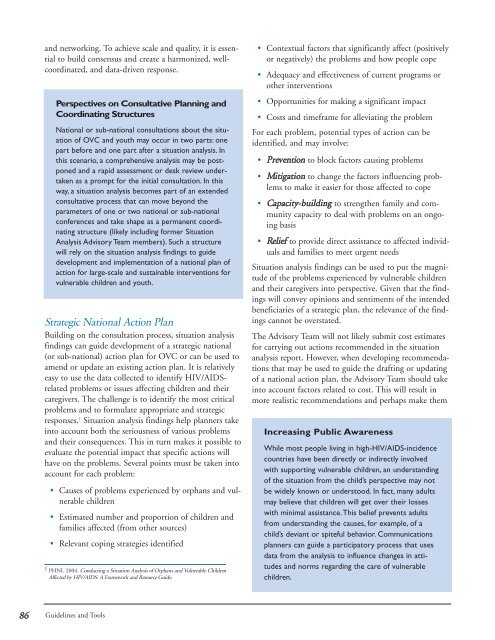Conducting a Participatory Situation Analysis of.pdf - Global HIV ...
Conducting a Participatory Situation Analysis of.pdf - Global HIV ...
Conducting a Participatory Situation Analysis of.pdf - Global HIV ...
You also want an ePaper? Increase the reach of your titles
YUMPU automatically turns print PDFs into web optimized ePapers that Google loves.
and networking. To achieve scale and quality, it is essential<br />
to build consensus and create a harmonized, wellcoordinated,<br />
and data-driven response.<br />
Perspectives on Consultative Planning and<br />
Coordinating Structures<br />
National or sub-national consultations about the situation<br />
<strong>of</strong> OVC and youth may occur in two parts: one<br />
part before and one part after a situation analysis. In<br />
this scenario, a comprehensive analysis may be postponed<br />
and a rapid assessment or desk review undertaken<br />
as a prompt for the initial consultation. In this<br />
way, a situation analysis becomes part <strong>of</strong> an extended<br />
consultative process that can move beyond the<br />
parameters <strong>of</strong> one or two national or sub-national<br />
conferences and take shape as a permanent coordinating<br />
structure (likely including former <strong>Situation</strong><br />
<strong>Analysis</strong> Advisory Team members). Such a structure<br />
will rely on the situation analysis findings to guide<br />
development and implementation <strong>of</strong> a national plan <strong>of</strong><br />
action for large-scale and sustainable interventions for<br />
vulnerable children and youth.<br />
Strategic National Action Plan<br />
Building on the consultation process, situation analysis<br />
findings can guide development <strong>of</strong> a strategic national<br />
(or sub-national) action plan for OVC or can be used to<br />
amend or update an existing action plan. It is relatively<br />
easy to use the data collected to identify <strong>HIV</strong>/AIDSrelated<br />
problems or issues affecting children and their<br />
caregivers. The challenge is to identify the most critical<br />
problems and to formulate appropriate and strategic<br />
responses. 1 <strong>Situation</strong> analysis findings help planners take<br />
into account both the seriousness <strong>of</strong> various problems<br />
and their consequences. This in turn makes it possible to<br />
evaluate the potential impact that specific actions will<br />
have on the problems. Several points must be taken into<br />
account for each problem:<br />
• Causes <strong>of</strong> problems experienced by orphans and vulnerable<br />
children<br />
• Estimated number and proportion <strong>of</strong> children and<br />
families affected (from other sources)<br />
• Relevant coping strategies identified<br />
1 PHNI. 2004. <strong>Conducting</strong> a <strong>Situation</strong> <strong>Analysis</strong> <strong>of</strong> Orphans and Vulnerable Children<br />
Affected by <strong>HIV</strong>/AIDS: A Framework and Resource Guide.<br />
• Contextual factors that significantly affect (positively<br />
or negatively) the problems and how people cope<br />
• Adequacy and effectiveness <strong>of</strong> current programs or<br />
other interventions<br />
• Opportunities for making a significant impact<br />
• Costs and timeframe for alleviating the problem<br />
For each problem, potential types <strong>of</strong> action can be<br />
identified, and may involve:<br />
• Prevention to block factors causing problems<br />
• Mitigation to change the factors influencing problems<br />
to make it easier for those affected to cope<br />
• Capacity-building to strengthen family and community<br />
capacity to deal with problems on an ongoing<br />
basis<br />
• Relief to provide direct assistance to affected individuals<br />
and families to meet urgent needs<br />
<strong>Situation</strong> analysis findings can be used to put the magnitude<br />
<strong>of</strong> the problems experienced by vulnerable children<br />
and their caregivers into perspective. Given that the findings<br />
will convey opinions and sentiments <strong>of</strong> the intended<br />
beneficiaries <strong>of</strong> a strategic plan, the relevance <strong>of</strong> the findings<br />
cannot be overstated.<br />
The Advisory Team will not likely submit cost estimates<br />
for carrying out actions recommended in the situation<br />
analysis report. However, when developing recommendations<br />
that may be used to guide the drafting or updating<br />
<strong>of</strong> a national action plan, the Advisory Team should take<br />
into account factors related to cost. This will result in<br />
more realistic recommendations and perhaps make them<br />
Increasing Public Awareness<br />
While most people living in high-<strong>HIV</strong>/AIDS-incidence<br />
countries have been directly or indirectly involved<br />
with supporting vulnerable children, an understanding<br />
<strong>of</strong> the situation from the child’s perspective may not<br />
be widely known or understood. In fact, many adults<br />
may believe that children will get over their losses<br />
with minimal assistance.This belief prevents adults<br />
from understanding the causes, for example, <strong>of</strong> a<br />
child’s deviant or spiteful behavior. Communications<br />
planners can guide a participatory process that uses<br />
data from the analysis to influence changes in attitudes<br />
and norms regarding the care <strong>of</strong> vulnerable<br />
children.<br />
86<br />
Guidelines and Tools















